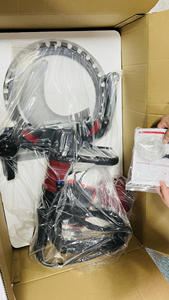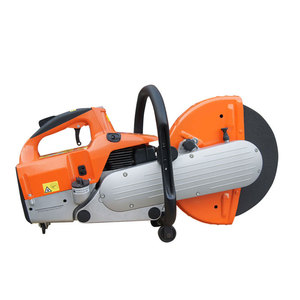(8613 products available)































































































































































































The power concrete cutter has many types that business buyers should know about. Each type offers unique features for different usage scenarios.
Floor saws
The saw is specifically designed for heavy-duty cutting tasks on horizontal surfaces. It usually comes with a large blade guard that can accommodate various diamond blades and a powerful engine that provides enough power to cut through concrete, asphalt, and other tough materials. A unique feature of a walk-behind concrete cutter is its self-propulsion system, which helps operator control the machine during cutting tasks without exerting much physical effort. Additionally, the machine may come equipped with water-delivery systems that help minimize dust and overheating of the blade during cutting operations.
Wall saws
The power concrete cutter is specifically designed to cut through concrete walls. It comprises a circular saw mounted on a rail tracked that is temporarily anchored to the wall that is being cut. One key advantages of wall saw cutters is that they offer to make precise cuts. Furthermore, these types of saws offer great control and minimal vibration, which reduces the risk of damage to the surrounding material. Also, wall saw cutters are available in both hydraulic- and gas-powered options. This means that operators can choose one that best suits their needs and preferences.
Handheld concrete saws
Handheld concrete saws offer great versatility and portability for medium- to small-sized cutting tasks. Users can easily maneuver the saw in tight spaces, cut overhead, and make specialty cuts such as curves or collars. Also, some models are equipped with anti-vibration technology, electric starters, and soft-grip handles for optimal user safety and comfort. The handheld concrete cutter can be powered in various ways, including gas-powered, hydraulic-powered, or electric-powered options. Gas-powered options are typically used for outdoor applications, while electric-powered options are used for indoor applications. Hydraulic-powered options are ideal for high-performance applications.
Wire saws
This type of concrete cutter utilizes a distinct cutting system consisting of a thin wire with diamond segments spaced along its length. Wire saws are ideal for making precise cuts in large concrete blocks, walls, and slabs. They excel in tackling complex shapes and providing minimal structural damage. One unique feature of a wire saw is its ability to make deep cuts without significantly increasing the weight of the cutting head. Additionally, wire saws reduce heat buildup and cutting stress through the elimination of blockages.
Groove cutting saws
A power groove cutting saw is designed to make narrow grooves in concrete surfaces. The primary function of a groove cutting saw is to create control joints or decorative patterns. A groove cutting saw creates neat and precise lines without damaging the surrounding areas. Operators can choose between a handheld or a walk-behind groove cutting saw depending on their needs and preferences.
The specifications of a concrete power cutter saws vary depending on the types and models available, but the specifications below are standard across various kinds of cutter saws.
Over time, concrete power cutters may need maintenance to keep them functional and effective. Some of the maintenance parts of a concrete power cutter include:
Roadworks and Infrastructure Projects
In the construction of highways, urban roads, and other road engineering, power concrete cutters are commonly used to carry out road repairs and to cut concrete slabs for expansion joints. They are also often used in infrastructure construction projects such as bridges and tunnels.
Renovation and Decoration Works
Power concrete cutters can be used in renovation and decoration works for the above to cut openings for pipes or electrical conduits in concrete walls and to cut windows and door openings, as well as to remove redundant concrete structures.
Industrial Manufacturing and Assembly
Power concrete cutters are also widely used in industrial manufacturing and assembly. For instance, in the automotive and aerospace industries, power concrete cutters can be used to customize and quickly produce various concrete components and parts. In electronics manufacturing, power concrete cutters can be used to cut and process concrete substrates and other related materials. In assembly and manufacturing lines, power concrete cutters can also be used for materials and quality control.
Road Maintenance and Repair
Power concrete cutters are also available in road maintenance and repair. For instance, when carrying out road maintenance operations, power concrete cutters can be used to cut out bad road sections or to repair and maintain road joints. When repairing road potholes, power concrete cutters can be used to mend the edges of potholes for better repair quality. Power concrete cutters can also be used for road markings and the cutting of lines when the markings are removed, ensuring that the road surface is intact.
These are just some common application scenarios. Depending on the model and function, power concrete cutters can also be applied to other scenarios.
When selecting power concrete cutters for resale or rental services, it is advisable to start with a target customer base analysis. This entails assessing the customer profiles, their preferred concrete cutter types, and applications. A thorough understanding of the customer bases' needs will provide insight into the most favored cutter types.
Regardless of the concrete cutter type, customers tend to prioritize efficiency and performance when selecting a cutting tool. Power, blade size, RPM, and motor type are some concrete cutter specifications that have an impact on cutting performance. To meet the diverse needs of customers, consider a selection of concrete cutters with varying specifications. Such a diverse range will adequately cater to different customers' preferences and application needs.
Aesthetics is another popular factor that affects customers' purchasing decisions. Consider the visual appeal of the concrete cutters during the selection process. Opt for well-designed cutters with appealing features that will entice potential customers. Furthermore, take into consideration the additional features and accessories that come with the concrete cutter, such as dust collection attachments and wet cutting capabilities. These features will enhance the user experience and attract more customers.
Focus on understanding the target customers' budgets. Typically, buy customers will look for tools that will give them a great return on investment. As such, the retail prices ought to be within the end users' budgets. To serve a wide end-user market, consider a range of concrete cutters at different prices. This will enable businesses to cater to various application needs and budgets. Finally, compliance with safety standards is an important factor to consider when selecting concrete cutters. Ensure the selected machines meet the required safety standards and have appropriate safety features, such as blade guards and emergency shutdown mechanisms.
Q: How thick of concrete will a power cutter cut?
A: The capacity of a concrete cutter to cut through concrete depends on the type of cutter being used. Handheld cutters can typically cut through concrete up to 6 inches thick. Walk-behind machines can cut up to 18 inches. Larger saws, like stationary or floor saws, can cut as much as 30 inches. The maximum cutting depth for any concrete saw will vary according to the blade used in the machine.
Q: How long does it take to cut concrete with a power cutter?
A: Cutting concrete with a power cutter can take anywhere from a few seconds to several hours, depending on the type of saw being used, the thickness of the concrete, and any obstacles that may be in the way. Pre-existing cracks and lines can help to make the cutting process faster and easier. Operators must prioritize safety over speed, and take the necessary time to cut effectively and safely.
Q: Is it worth sealing cracked concrete?
A: Sealing cracked concrete is worth it. Doing this prevents water from getting into the cracks and freezing, which will cause the cracks to expand. Preventing water from entering the cracks can prolong the life of the concrete and keep it from further damage.
Q: What are the different types of concrete cutters?
A: The types of concrete cutters include: